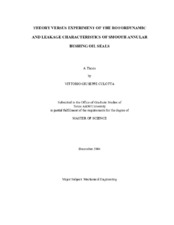| dc.description.abstract | This thesis provides a comparison of experimental rotordynamic coefficients for
laminar, smooth bushing oil seals to theoretical predictions from XLLubeGT and
XLAnSeal. The experimental results come from a new test rig developed at the
Turbomachinery Laboratory at Texas A&M University. The two software programs
were developed to predict the static and dynamic characteristics of seals. XLLubeGT is
a Reynolds equation based program while XLAnSeal is based on a bulk-flow Navier-
Stokes model that includes temporal and convective acceleration terms. XLAnSeal was
used to predict the added-mass terms of the seals since XLLubeGT assumes those terms
to be zero or negligible. The data used for input into the two seals code was the actual
measured conditions from the test rig. As part of the input parameters, inlet inertia
effects and thermal gradients along the seal were included. Both XLLubeGT and
XLAnSeal have the capability to analyze straight bore seals with different inlet and
outlet clearances – essentially a tapered seal – but seal expansion caused by the radial
differential pressure across the seal bushing was not included.
Theoretical and experimentally determined dynamic characteristics include
stiffness, damping, inertia terms and Whirl Frequency Ratio (WFR). Seal static
characteristics are also reported. They include: leakage, shaft center line loci and
Reynolds numbers. Test conditions include three shaft speeds: 4000, 7000 and 10,000
rpm, three test pressures: 21, 45 and 69 bar [300, 650, and 1000 psi] and multiple
eccentricities from 0.0 to 0.7. The results for the dynamic characteristics show good
correlation of the experimental data to the theoretical values up to an eccentricity of
about 0.5. At higher eccentricities, the theory generally under-predicts the dynamic
characteristics. Inertia terms are greatly under-predicted. The results for the static
characteristics also show good correlation to the experimental data, but they also have a
tendency to be under-predicted at higher eccentricities. | en |


